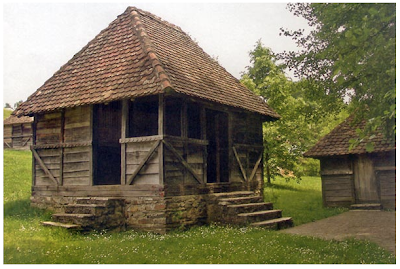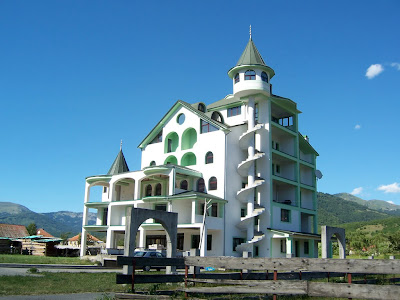In the past 5 lessons of “Traditional Serbian Rural Architecture” I wrote about the two basic styles of rural houses “brvnare” and “bondruke”, about the different rural styles of the areasof Serbia, about the South Serbian Village, about the SerbianHomestead and about Serbian traditional interiors.
(picture from "srpskekuce")
(picture from "srpskekuce")
Now I ask myself how to translate old rural architecture into new rural architecture. If I'm planning to renovate an old rural house in Serbia, how will the “new” or renovated rural house looks like?
From the two extremes like to rebuild a building exactly like it was (with walls of mud and straw) or to build something completely new that has no connection with what it was before (as some of the "gastarbajterske kuce" I wrote about on Balkan-Crew) lot of ideas come to my mind.
That's what people would probably expect: a crazy Migrant-worker-Villa. Unfortunately, often when somebody renovates or build a house in a village, he wants to show off and impress with a huge dimension and with expensive looking stuff. The only thing we knew was: we do not want that! (picture from skyscrapercity)
So I collected my thoughts about traditional Serbian rural architecture:
Rural Buildings and architecture is related to lifestyle, mentality, social structure of the people of the surroundings.
If in the past houses were built with just what the area offered, today we have a waste choice of materials and products. If in the past, several generations were living in form of a “zadruga” (clan) in the same building, now there is rather one generation with occasionally a parent or so in the house. If in the past several men organized the outdoor and several women were organizing the household, now it's rather one couple doing the whole. Even if the mentality stayed, the lifestyle and social structures changed from the past, the architecture can not be exactly the same today as it used to be.
It's important not to erase the history from an existing house. History has influenced Serbian tradition a few times, often in a violent way. So it its national style should be preserved. It would be wrong to create a neutral style (a globalized style) or to build a new house that could stand anywhere in the world (sometimes this neutral style can be the greatest threat of identity of people).
A fantastic old house from Tihomir's blog
Modern technologies give new possibilities of the use of materials or gives new construction solution.
So it was a wish to work with new but natural materials, to fulfill perfectly all the functions that the house has to accomplish, without using experimental and artificial materials, that nobody knows how long they're going to last.
So it was a wish to work with new but natural materials, to fulfill perfectly all the functions that the house has to accomplish, without using experimental and artificial materials, that nobody knows how long they're going to last.
However all the new structures should blend well with the old and with the found surrounding. The trick is to find the balance between the new design and the old structure.
The characteristics of rural architecture can be preserved by copying the external characteristics of the existing surrounding buildings.
However, the new building must represent the interests, the needs and the habits of the future users. We can see it as a newer content put in an traditional form.
Where a newer building blend well with the traditional forms (picture from flickr)
The characteristics of rural architecture can be preserved by copying the external characteristics of the existing surrounding buildings.
However, the new building must represent the interests, the needs and the habits of the future users. We can see it as a newer content put in an traditional form.
Architecture is always a dialogue with the surrounding. If we pay attention to what we discover in the surrounding, we easily find answers to the questions which style or which architectural language works better when we start to work on an existing house.
A building that blends with the surrounding (picture from flickr)
What's always been there blends better with the surrounding than a complete new language of forms and patterns.
Keeping those ideas in mind I started to jot down sketches for the house transformation........






Thanks for the great reference post. Just what I was looking for! The information is really helpful with my research.
ReplyDeleteInteresting read!
ReplyDelete